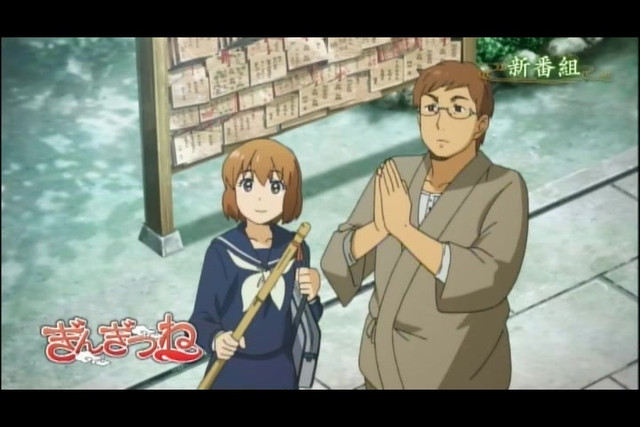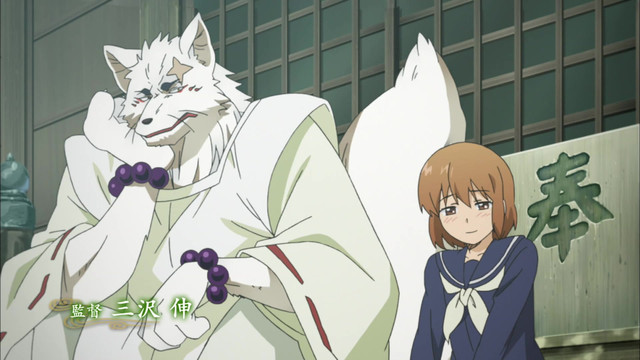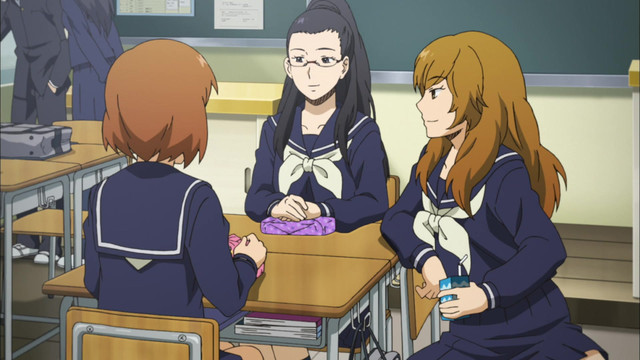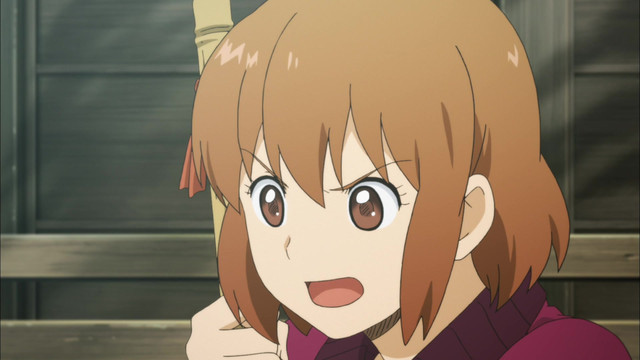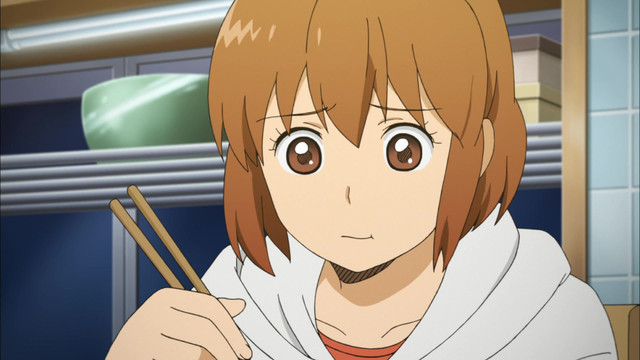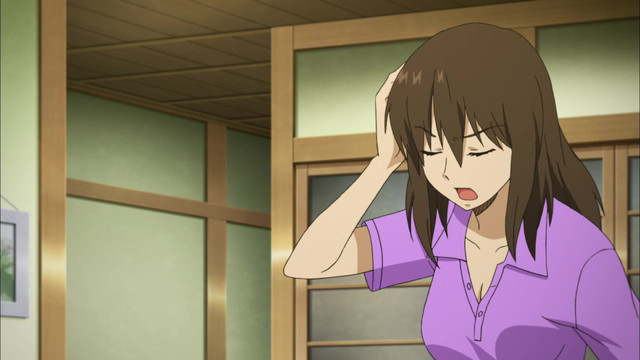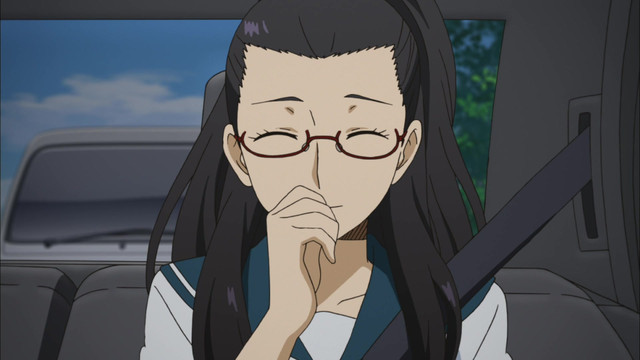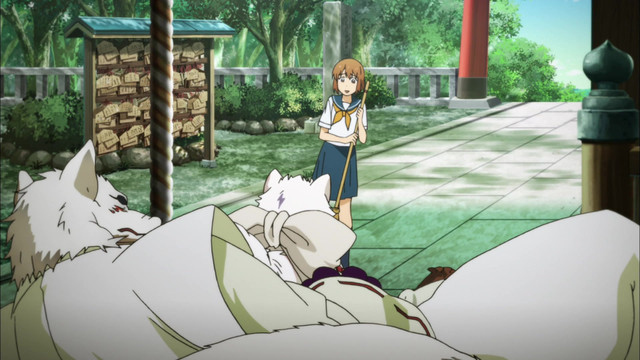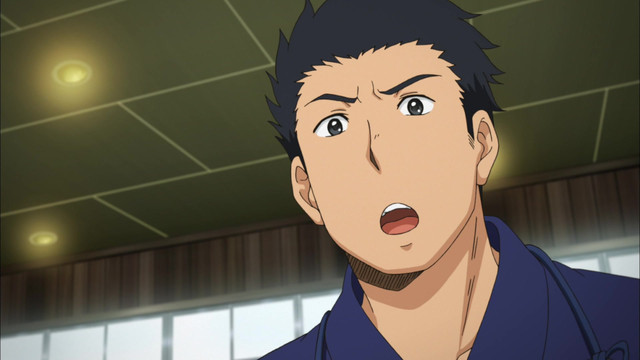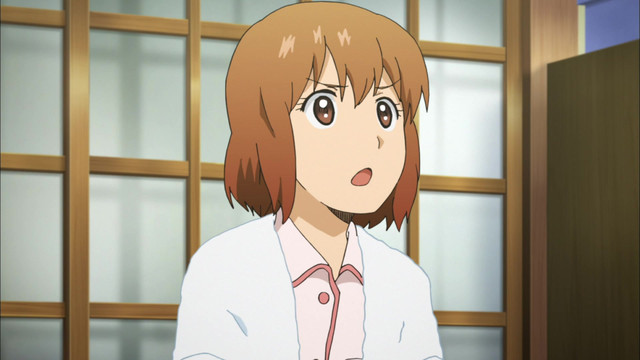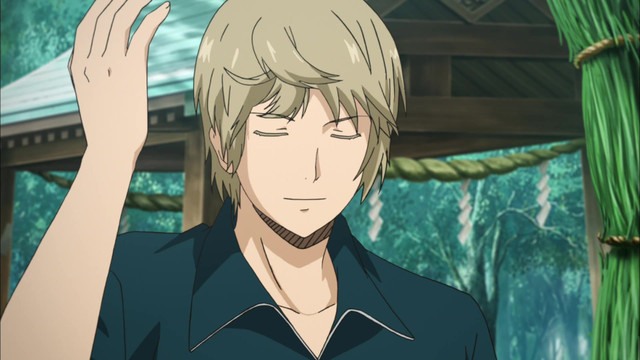GINGITSUNE
STATUS
COMPLETE
EPISODES
12
RELEASE
December 23, 2013
LENGTH
24 min
DESCRIPTION
Gintaro is a fox spirit that has been protecting the small Inari temple since the Edo era. Saeki Makoto's family possesses the power to see the gods' agent, but the ability is limited to one living relative at a time. When Makoto's mother passed away while she was still young, Makoto inherited the ability as the sole remaining family member. With the help of fox spirit's power, Makoto and Gintaro help the people of their community, in spite of their many differences.
(Source: MangaHelpers; edited)
CAST

Gintarou

Shinichirou Miki

Makoto Saeki

Kanae Itou

Satoru Kamio

Kenshou Ono

Haru

Ayumi Fujimura

Yumi Ikegami

Chinatsu Akasaki

Tatsuo Saeki

Toshihiko Seki

Aki Fukuda

Mari Hino

Hiwako Funabashi

Ami Koshimizu

Fujino Amamoto

Rumi Ookubo

Kikuri Amamoto

Kame

Kanehira Yamamoto

Mother Amamoto

Sayuri Sadaoka

Nanami Kosugi

Hiroyuki Yoshino

Otomatsu

Bin Sasaki

Father Amamoto

Binbin Takaoka

Utamaru

Youji Ueda

Kozue Ashihara

You Taichi

Sachina Seto

Chiaki Mori

Saimaru

Naomi Kusumi

Saki Suzui

Ayaka Suwa

Kinjiro

Kazuhiko Inoue

Shouhei Amamoto

Tomokazu Seki

Yoshitomo Takami

Hiroaki Hirata

Fuku

Kotori Koiwai

Etsuko Toyokura

Atsuko Tanaka
EPISODES
Dubbed
RELATED TO GINGITSUNE
 MANGA ComedyGingitsune
MANGA ComedyGingitsuneREVIEWS

GustavoMuns
68/100Has an interesting plot about shintoism, but fails in aspects like character development and unresolved issues.Continue on AniListREVIEW IN ENGLISH AND PORTUGUESE (BRAZIL);
MY REVIEW ON MYANIMELIST: link
» ENGLISH:
The narrative of "Gingitsune" begins by introducing us to Makoto Saeki and Tatsuo Saeki (her father), who live in an Inari Shrine. The young Makoto has received a special gift that allows her to see and interact with spirits, known as heralds. This gift is passed down from generation to generation, and the last person to possess it was her mother.
In the Inari Shrine, there is a fox herald named Gintaro, a large, white, and very lazy fox who seems to be a big fan of tangerines! Gintaro can only be seen by other heralds and by humans who have this gift. Thus, Makoto's father cannot see him, as he was not "blessed" with this ability. The heralds act as emissaries of the Inari Shrine, being able to predict the future and locate lost things, assisting in solving problems.
In the first episodes, we are introduced to the peculiarities of friendships, such as the attempt to bond between Makoto and Gintaro. But since she is very young, she still has a lot to learn and master with his help. Later, Makoto makes new friends, who end up experiencing a small problem, but soon they reconcile and become great friends.
The second half focuses more on the new resident and now friend of Makoto, Satoru, and his herald Haru. In this second half, we also witness the consolidation of the bond between Makoto and Gintaro, where despite being rude to her, he still has feelings and, thinking that Makoto might die before him, feels the need to instruct her and learn from his mediator. In the world of heralds, they live for a long time and witness the birth and death of their mediators over the ages, powerless before this continuous cycle.As the story progresses, we follow the slow change in Makoto's personality, who at first is an insecure and naive girl who does not know how to deal well with the problems of the Inari Shrine. The fight that happens with her new friends is another step for her to evolve in her being. So, with the help and support of her friends and Gintaro to make her feel better, she evolves into a better person, acquiring the necessary responsibility to deal with her abilities and her new life, always accompanied by her friends.
However, when we finish watching, we see that the anime failed to clearly explain some issues, such as the whereabouts of Gintaro's former partner, the white fox named Kinjiro. This character is remembered a few times in the story, either by flashbacks or feelings that Gintaro expresses when Makoto asks about his old partner. The narrative only mentions that he left for another place, without explaining his current situation or if he still misses his former partner. This lack of explanation leaves a question mark, which could be resolved with more details or in a new season.
Moreover, Satoru's development could have been much more in-depth because, when we see his flashback with Haru, we see that he suffered a lot to get to where he is today, but he ended up not having a very worthy ending, just being a mere supporting character for Makoto. Satoru didn't need to be the “center of attention,” but he could have had a much more significant conclusion to the story.The design of the human characters was kept in a simpler and more realistic manner, focusing a lot on the real-life aspect. The colors of these characters' clothes are usually very neutral, never trying to be anything extravagant or exaggerated, just trying to convey the vibe of being real. Because of this, the design of the heralds is pure fantasy, having much more detail to collaborate with the theme of the anime, giving them an air of being very different and unrealistic compared to the human characters.
This perception is very noticeable when Makoto stands next to Gintaro in some scenes. The heralds are also very different, and none are similar to each other, so when Gintaro is next to Haru, we see that they are also very unique and different. This is also important because of the personalities of the heralds, while Gintaro is more relaxed and lazy, Haru is more agitated and irritating, given that she would be 10 years old in human age, which is plausible considering her personality dependent on her mediator Satoru.The representation of the settings is a good reflection of what the work tries to capture and explain to viewers, making this representation of settings with care for a good construction of the environment.
This representation is clear in the shrines and temples, which are full of details and very realistic, showing us a tradition and knowledge of how they work. This functionality is based on the ceremonies and customs that the young Makoto and her friends end up performing throughout the anime. The background landscapes of these shrines and temples are always something with very green forests, lively things, which perfectly highlights the nature of the place, while in the city it is more focused on urbanization, having many more cars and tall buildings.However, I would say that “Gingitsune” was very well done within the slice-of-life and fantasy genre, where it very well presented the shintoism theme, representing it in a broad way that makes viewers understand what is happening, serving well to generate a better understanding of how the customs and ceremonies work and are managed. But despite this, it failed to generate considerable development in other characters who deserved this development as well, and it still left some unexplained questions in the air, and it's not as if they were just “theorize this your way,” because they needed a better and more in-depth explanation. Such issues could be resolved in a new season, as I suggested a little above this text.
FINAL RATING: 6.8/10
» PORTUGUÊS (BRASIL):
A narrativa de "Gingitsune começa nos apresentando Makoto Saeki e Tatsuo Saeki (seu pai), que vivem em um Santuário Inari. A jovem Makoto recebeu um dom especial que lhe permite ver e interagir com os espíritos, chamados de arautos. Esse dom é passado de geração em geração, e a última pessoa a possuí-lo foi sua mãe.
No Santuário Inari, há um arauto da raposa chamado Gintaro, uma raposa grande, branca e muito preguiçosa, que parece ser fã número um de tangerinas! Gintaro só pode ser visto por outros arautos e pelos humanos que têm esse dom. Assim, o pai de Makoto não consegue vê-lo, pois não foi "abençoado" com essa habilidade. Os arautos atuam como emissários do Santuário Inari, sendo capazes de prever o futuro e localizar coisas perdidas, auxiliando na resolução de problemas.
Nos primeiros episódios, somos apresentados às particularidades das amizades, como a tentativa de vínculo entre Makoto e Gintaro. Mas como ela é muito nova, ainda tem muito a aprender e dominar com a ajuda dele. Mais tarde, Makoto ganha novas amigas, que acabam vivenciando um pequeno problema, mas logo elas voltam a ser amigas, se reconciliando do problema passado.
Na segunda metade é mais sobre o novo morador e agora amigo de Makoto, Satoru, e seu arauto Haru. Nessa segunda metade também testemunhamos a consolidação do vínculo entre Makoto e Gintaro, onde apesar dele ser rude com ela, ele ainda possui sentimentos e, pensando que Makoto pode morrer antes dele, sente a necessidade de instruí-la e aprender com sua mediadora. No mundo dos arautos, eles vivem por muito tempo e testemunham o nascimento e a morte de seus mediadores ao longo das eras, impotentes perante esse ciclo contínuo.Ao decorrer da obra, vamos acompanhando a lenta mudança de personalidade em Makoto, que no começo é uma garota insegura e ingênua, que não sabe lidar muito bem com os problemas do Santuário Inari. A briga que acontece com suas novas amigas é mais um passo para que ela consiga evoluir em seu ser. Então com a ajuda e o apoio que seus amigos e Gintaro fazem para ela se sentir melhor, ela evolui como uma pessoa melhor, adquirindo a responsabilidade necessária para lidar com suas habilidades e sua nova vida, sempre acompanhada pelos seus amigos.
No entanto, quando terminamos de assistir, vemos que o anime não conseguiu explicar com clareza algumas questões, como o paradeiro do ex-parceiro de Gintaro, a raposa branca chamada Kinjiro. Esse personagem é lembrado algumas vezes na história, seja por flashbacks ou sentimentos que Gintaro expressa quando Makoto pergunta sobre seu antigo parceiro para ele. A narrativa apenas menciona que ele foi embora para outro lugar, sem explicar sua situação atual ou se ele ainda sente falta do seu ex-parceiro. Essa falta de explicação deixa uma dúvida no ar, que poderia ser resolvida com mais detalhes ou em uma nova temporada.
Além do mais, o desenvolvimento de Satoru poderia ter sido muito mais aprofundado, pois, quando vemos o seu flashback junto de Haru, vemos que ele sofreu muito para chegar no que é hoje, mas acabou não tendo um final tão digno de ser, apenas sendo um mero coadjuvante de Makoto. Satoru não precisava ser o “centro das atenções”, mas poderia ter um desfecho muito mais significativo para a história.O design dos personagens humanos foi mantido de uma forma mais simplista e realista, focando muito no quesito da vida real. As cores das roupas desses personagens são geralmente muito neutras, nunca buscando ser nada extravagante ou exagerado, apenas tentando passar a vibe de serem reais. Em virtude disso, o design dos arautos é buscado a pura fantasia, tendo muito mais detalhes para a colaboração com o tema do anime, dando-os um ar de serem muito diferentes e irrealistas que os personagens humanos.
Essa percepção fica muito destacavel quando Makoto fica ao lado de Gintaro em alguma cena. Os arautos também são bem diferentes, e nenhum é parecido com o outro, então quando Gintaro está ao lado de Haru, vemos que eles também são bem únicos e diferentes. Isso também é importante por conta das personalidade dos arautos, enquanto Gintaro é mais relaxado e preguiçoso, Haru é mais agitada e irritante, dado que ela teria 10 anos em idade humana, o que é plausível considerando sua personalidade dependente do seu mediador Satoru.A representação dos cenários é um bom reflexo do que a obra tenta captar e explicar aos espectadores, tornando essa representação de cenários com cuidado para uma boa construção do ambiente.
Essa representação é nítida nos santuários e templos, que são cheios de detalhes e muito realistas, mostrando-nos uma tradição e conhecimento de como eles funcionam. Essa funcionalidade é baseada nas cerimônias e costumes que a jovem Makoto e seus amigos acabam fazendo no decorrer do anime. As paisagens do cenário ao fundo desses santuários e templos sempre é algo com florestas bem verdes, coisas vividas, o que realça perfeitamente a natureza do local, enquanto na cidade é mais focado na urbanização, tendo muito mais carros e prédios altos.Contudo eu diria que “Gingitsune" foi muito bem feito dentro do gênero slice-of-life e fantasia, onde apresentou muito bem o tema xintoísta o representando de uma maneira ampla que faz os telespectadores entenderem o que está ocorrendo, servindo bastante para gerar um melhor conhecimento de como os os costumes e cerimônias funcionam e são geridos. Mas apesar disso, ele não conseguiu gerar um desenvolvimento considerável em outros personagens que mereciam esse desenvolvimento também, e ele ainda deixou algumas questões não esclarecidas no ar, e não é como se elas fossem apenas “teorize isso da sua maneira”, pois elas necessitavam de uma explicação melhor e mais aprofundadas. Tais questões poderiam ser resolvidas em uma nova temporada, como eu bem sugeri em um pouco acima desse texto.
NOTA FINAL: 6.8/10
SIMILAR ANIMES YOU MAY LIKE
 ANIME ComedyKamisama Hajimemashita
ANIME ComedyKamisama Hajimemashita ANIME DramaNatsume Yuujinchou
ANIME DramaNatsume Yuujinchou ANIME ComedyTamako Market
ANIME ComedyTamako Market ANIME ComedyNekogami Yaoyorozu
ANIME ComedyNekogami Yaoyorozu ANIME ComedyEdomae Elf
ANIME ComedyEdomae Elf ANIME AdventureBinbougami ga!
ANIME AdventureBinbougami ga!
SCORE
- (3.4/5)
MORE INFO
Ended inDecember 23, 2013
Main Studio diomedéa
Favorited by 52 Users

